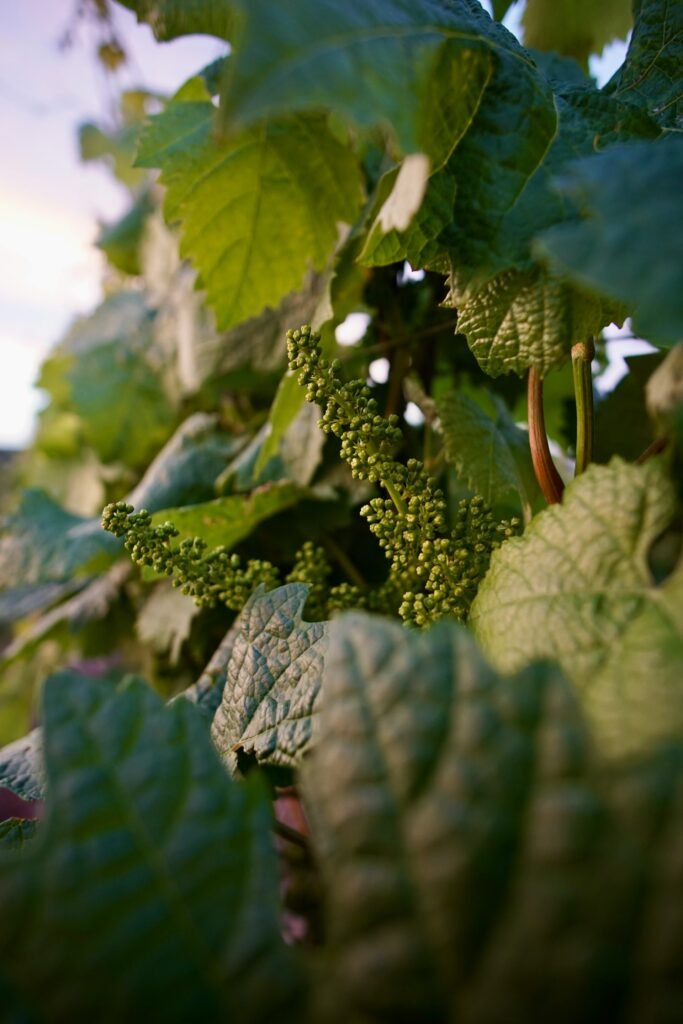Hello, curious minds! Today, let’s set off on an adventure to explore the wonders of Vitis arizonica, better known as the Canyon Grape. Nestled in the rocky canyons of the southwestern United States, this grape variety holds a treasure trove of surprises waiting to be discovered. So, grab your magnifying glass, and let’s delve into it’s secrets!
What does a Canyon Grape look like?
It is a vine, which means it loves to climb over rocks, shrubs, and trees. It has woody stems that grow quite long, and they stay secure because of forked tendrils at their tips. The leaves are somewhat heart-shaped and coarsely toothed. They are dark green when mature and turn stunning shades of red in the fall. The vine can climb to 16 feet tall and wide.

Where do Canyon Grapes grow?
You can find it growing along streams and shady canyons, often climbing in trees. It’s native to Arizona, Texas, Utah, and northern Mexico, growing between elevations of 2,000 and 7,500 feet.
A Splash of Color in the Canyon
It isn’t just about survival; it also adds a touch of beauty to the desert. In the spring, the vine produces delicate yellow flowers that bring a pop of color to the canyon walls. Later in the summer, the green grapes slowly turn a deep purple, adding another layer of visual interest to the rugged landscape.
A Grape with Gumption
Imagine a grapevine that can handle scorching sun, dry winds, and rocky slopes. That’s the canyon grape for you! Unlike its plump, juicy cousins, it produces small, tart berries that aren’t exactly what you’d call a delicious snack. But hey, survival isn’t about gourmet meals! These grapes help the vine survive in its tough environment.
A Sweet Surprise for Wildlife
While the taste might not be your cup of tea (or juice!), desert wildlife love them! Birds, raccoons, and even bighorn sheep gobble up these tart treats. The grapes provide them with a much-needed source of food and moisture in the dry desert landscape.
What are uses of the Canyon Grape?
It has many uses. Its ripe fruit is fairly small but useful in making juice, syrups, sweets, and they can be dried for later use in the winter months. The fruit makes delicious preserves and wine. The leaves can be used to wrap foods and then baked. They impart a very pleasant taste when baked. They can be used in soups and stews as well. Young tendrils can be pickled or tossed into salads.

What are benefits of the Canyon Grape?
The Canyon Grape is not just a plant; it’s a source of food that’s readily abundant and adds nutrition to your diet. It’s also being studied extensively to improve wine grapes. Recent research has shown Arizona grape is more resistant to Pierce’s disease than cultivated forms. Scientists hope that hybrids between Arizona and wine grape will reduce the incidence of the disease.
- Nature’s Sweet Treat: Despite its harsh habitat, it produces clusters of small, sweet berries that delight the taste buds. These grapes are bursting with flavor, offering a refreshing sweetness that’s perfect for snacking or adding to recipes.
- Medicinal Marvel: Traditional healers have long recognized the medicinal properties. The grapes, leaves, and stems contain compounds believed to have antioxidant and anti-inflammatory effects, making them valuable ingredients in herbal remedies.
- Ecosystem Support: Beyond its culinary and medicinal uses, it plays a vital role in supporting local ecosystems. Its dense foliage provides shelter and nesting sites for birds and small mammals, while its fruits attract a variety of wildlife, including birds and insects.
- Cultural Significance: Native American communities have a deep cultural connection to the it, incorporating it into their traditional practices and ceremonies. For centuries, these grapes have been revered as symbols of abundance, vitality, and resilience.
A Potential Future Player?
Scientists are starting to take a closer look at the canyon grape. Because it thrives in hot, dry climates, it might be a good candidate for breeding new grape varieties that can withstand the effects of climate change. Who knows? Maybe one day, there could be a canyon grape-inspired wine on the shelves!
What are drawbacks of the Canyon Grape?
While it offers many benefits, it’s essential to consider potential drawbacks:
- Limited Availability: Due to its specific habitat requirements, it may not be as readily available as other grape varieties. Harvesting them can also be challenging, given their remote and often inaccessible growing locations.
- Harsh Growing Conditions: Growing it commercially can be difficult due to the harsh environmental conditions they prefer. The rocky, arid terrain and limited water availability pose significant challenges for cultivation.
- Competitive Interactions: In some cases, it may face competition from invasive plant species, which can outcompete them for resources and threaten their survival in the wild.
In Summary
A Desert Dweller with Hidden Potential
Vitis arizonica, or the Canyon Grape, is a true marvel of nature, thriving in some of the most rugged and inhospitable landscapes. From its sweet berries to its medicinal properties and cultural significance, this grapevine species has captured the hearts and imaginations of all who encounter it. While it may have its challenges, it continues to remind us of the resilience and beauty of life in the wild.
Happy exploring, my fellow adventurers!
Affiliate Links
Related Reading
Canyon Grape: Pictures, Flowers, Leaves & Identification | Vitis arizonica. https://www.ediblewildfood.com/canyon-grape.aspx.
Vitis arizonica – Wikipedia. https://en.wikipedia.org/wiki/Vitis_arizonica.
Arizona Grape – US Forest Service. https://www.fs.usda.gov/wildflowers/plant-of-the-week/vitis_arizonica.shtml.

Leave a Reply